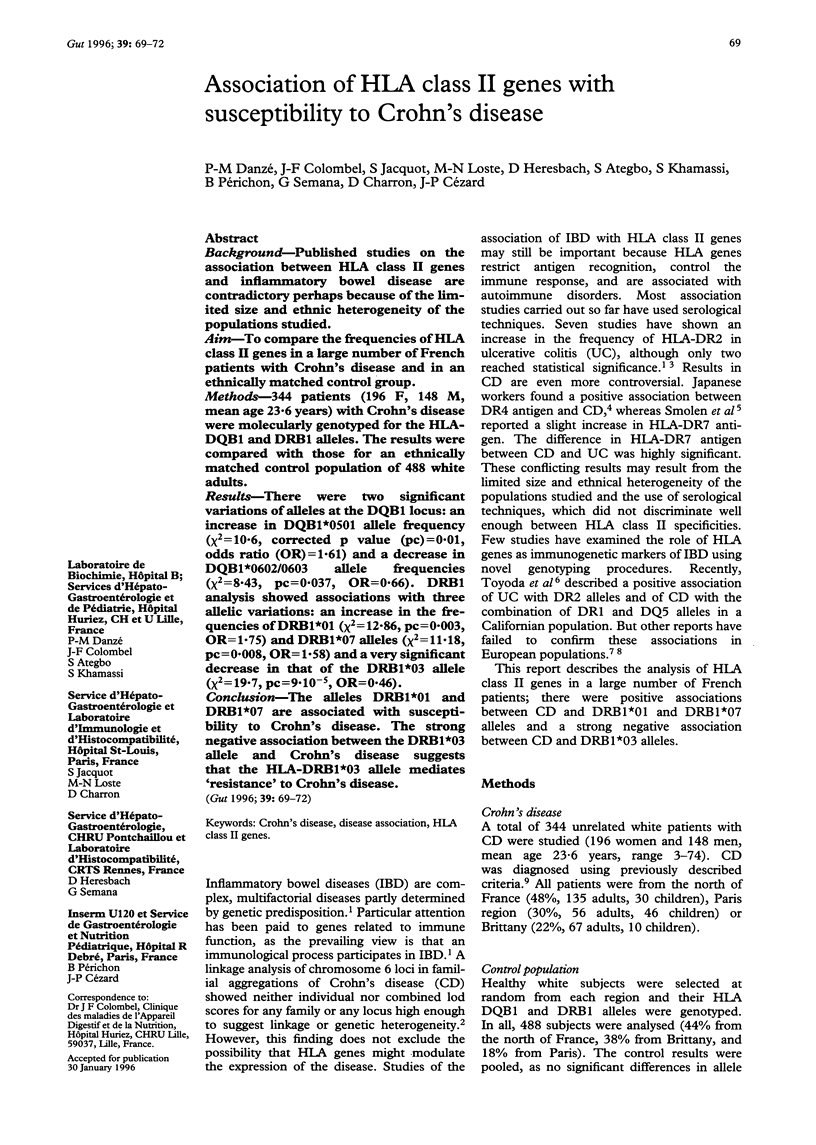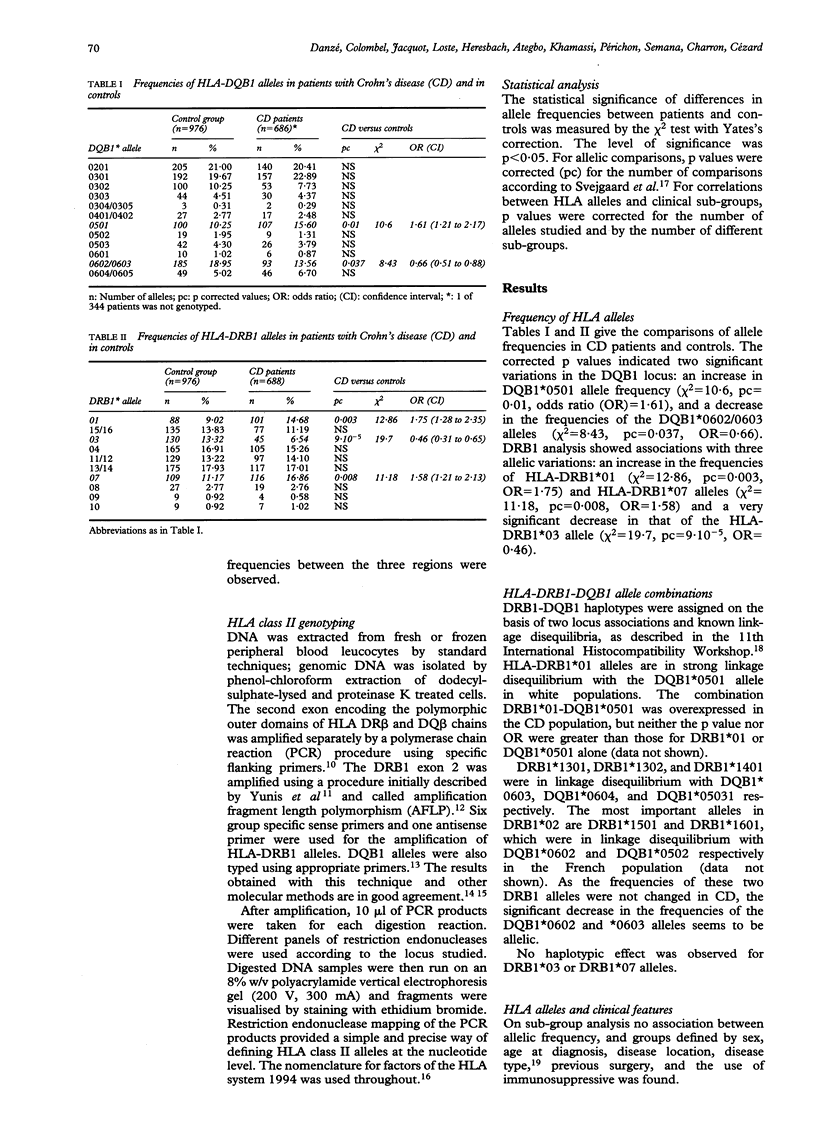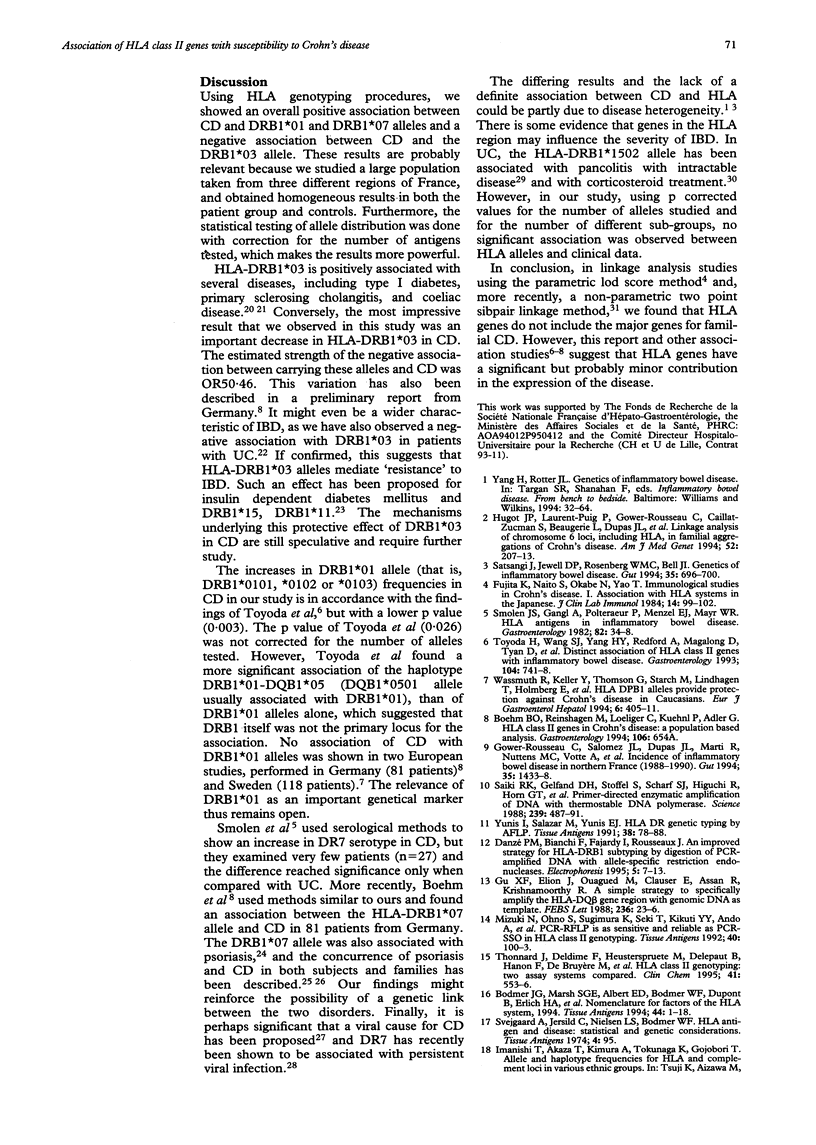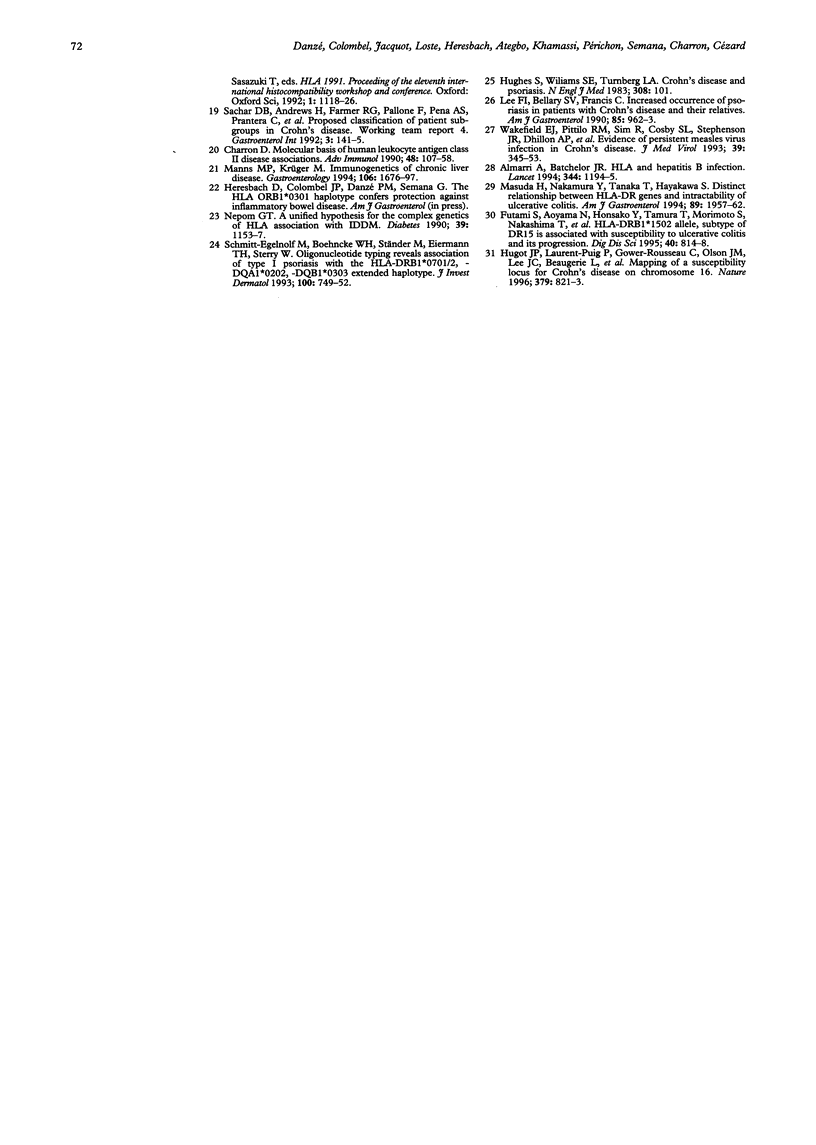Abstract
BACKGROUND: Published studies on the association between HLA class II genes and inflammatory bowel disease are contradictory perhaps because of the limited size and ethnic heterogeneity of the populations studied. AIM: To compare the frequencies of HLA class II genes in a large number of French patients with Crohn's disease and in an ethnically matched control group. METHODS: 344 patients (196 F, 148 M, mean age 23.6 years) with Crohn's disease were molecularly genotyped for the HLA-DQB1 and DRB1 alleles. The results were compared with those for an ethnically matched control population of 488 white adults. RESULTS: There were two significant variations of alleles at the DQB1 locus: an increase in DQB1*0501 allele frequency (chi 2 = 10.6, corrected p value (pc) = 0.01, odds ratio (OR) = 1.61) and a decrease in DQB1*0602/0603 allele frequencies (chi 2 = 8.43, pc = 0.037, OR = 0.66). DRB1 analysis showed associations with three allelic variations: an increase in the frequencies of DRB1*01 (chi 2 = 12.86, pc = 0.003, OR = 1.75) and DRB1*07 alleles (chi 2 = 11.18, pc = 0.008, OR = 1.58) and a very significant decrease in that of the DRB1*03 allele (chi 2 = 19.7, pc = 9.10(-5), OR = 0.46). CONCLUSION: The alleles DRB1*01 and DRB1*07 are associated with susceptibility to Crohn's disease. The strong negative association between the DRB1*03 allele and Crohn's disease suggests that the HLA-DRB1*03 allele mediates 'resistance' to Crohn's disease.
Full text
PDF



Selected References
These references are in PubMed. This may not be the complete list of references from this article.
- Almarri A., Batchelor J. R. HLA and hepatitis B infection. Lancet. 1994 Oct 29;344(8931):1194–1195. doi: 10.1016/s0140-6736(94)90510-x. [DOI] [PubMed] [Google Scholar]
- Bodmer J. G., Marsh S. G., Albert E. D., Bodmer W. F., Dupont B., Erlich H. A., Mach B., Mayr W. R., Parham P., Sasazuki T. Nomenclature for factors of the HLA system, 1994. Tissue Antigens. 1994 Jul;44(1):1–18. doi: 10.1111/j.1399-0039.1994.tb02351.x. [DOI] [PubMed] [Google Scholar]
- Charron D. Molecular basis of human leukocyte antigen class II disease associations. Adv Immunol. 1990;48:107–159. doi: 10.1016/S0065-2776(08)60753-1. [DOI] [PMC free article] [PubMed] [Google Scholar]
- Danzé P. M., Bianchi F., Fajardy I., Rousseaux J. An improved strategy for HLA-DRB1 subtyping by digestion of PCR-amplified DNA with allele-specific restriction endonucleases. Appl Theor Electrophor. 1995;5(1):7–13. [PubMed] [Google Scholar]
- Fujita K., Naito S., Okabe N., Yao T. Immunological studies in Crohn's disease. I. Association with HLA systems in the Japanese. J Clin Lab Immunol. 1984 Jun;14(2):99–102. [PubMed] [Google Scholar]
- Futami S., Aoyama N., Honsako Y., Tamura T., Morimoto S., Nakashima T., Ohmoto A., Okano H., Miyamoto M., Inaba H. HLA-DRB1*1502 allele, subtype of DR15, is associated with susceptibility to ulcerative colitis and its progression. Dig Dis Sci. 1995 Apr;40(4):814–818. doi: 10.1007/BF02064985. [DOI] [PubMed] [Google Scholar]
- Gower-Rousseau C., Salomez J. L., Dupas J. L., Marti R., Nuttens M. C., Votte A., Lemahieu M., Lemaire B., Colombel J. F., Cortot A. Incidence of inflammatory bowel disease in northern France (1988-1990). Gut. 1994 Oct;35(10):1433–1438. doi: 10.1136/gut.35.10.1433. [DOI] [PMC free article] [PubMed] [Google Scholar]
- Gu X. F., Elion J., Ouagued M., Clauser E., Assan R., Krishnamoorthy R. A simple strategy to amplify specifically the HLA-DQ beta gene region with genomic DNA as template. FEBS Lett. 1988 Aug 15;236(1):23–26. doi: 10.1016/0014-5793(88)80278-3. [DOI] [PubMed] [Google Scholar]
- Hughes S., Williams S. E., Turnberg L. A. Crohn's disease and psoriasis. N Engl J Med. 1983 Jan 13;308(2):101–101. [PubMed] [Google Scholar]
- Hugot J. P., Laurent-Puig P., Gower-Rousseau C., Caillat-Zucman S., Beaugerie L., Dupas J. L., Van Gossum A., Bonäit-Pellie C., Cortot A., Thomas G. Linkage analyses of chromosome 6 loci, including HLA, in familial aggregations of Crohn disease. G.E.T.A.I.D. Am J Med Genet. 1994 Aug 15;52(2):207–213. doi: 10.1002/ajmg.1320520216. [DOI] [PubMed] [Google Scholar]
- Hugot J. P., Laurent-Puig P., Gower-Rousseau C., Olson J. M., Lee J. C., Beaugerie L., Naom I., Dupas J. L., Van Gossum A., Orholm M. Mapping of a susceptibility locus for Crohn's disease on chromosome 16. Nature. 1996 Feb 29;379(6568):821–823. doi: 10.1038/379821a0. [DOI] [PubMed] [Google Scholar]
- Lee F. I., Bellary S. V., Francis C. Increased occurrence of psoriasis in patients with Crohn's disease and their relatives. Am J Gastroenterol. 1990 Aug;85(8):962–963. [PubMed] [Google Scholar]
- Manns M. P., Krüger M. Immunogenetics of chronic liver diseases. Gastroenterology. 1994 Jun;106(6):1676–1697. doi: 10.1016/0016-5085(94)90427-8. [DOI] [PubMed] [Google Scholar]
- Masuda H., Nakamura Y., Tanaka T., Hayakawa S. Distinct relationship between HLA-DR genes and intractability of ulcerative colitis. Am J Gastroenterol. 1994 Nov;89(11):1957–1962. [PubMed] [Google Scholar]
- Mizuki N., Ohno S., Sugimura K., Seki T., Kikuti Y. Y., Ando A., Ota M., Tsuji K., Inoko H. PCR-RFLP is as sensitive and reliable as PCR-SSO in HLA class II genotyping. Tissue Antigens. 1992 Aug;40(2):100–103. doi: 10.1111/j.1399-0039.1992.tb01967.x. [DOI] [PubMed] [Google Scholar]
- Nepom G. T. A unified hypothesis for the complex genetics of HLA associations with IDDM. Diabetes. 1990 Oct;39(10):1153–1157. doi: 10.2337/diab.39.10.1153. [DOI] [PubMed] [Google Scholar]
- Saiki R. K., Gelfand D. H., Stoffel S., Scharf S. J., Higuchi R., Horn G. T., Mullis K. B., Erlich H. A. Primer-directed enzymatic amplification of DNA with a thermostable DNA polymerase. Science. 1988 Jan 29;239(4839):487–491. doi: 10.1126/science.2448875. [DOI] [PubMed] [Google Scholar]
- Satsangi J., Jewell D. P., Rosenberg W. M., Bell J. I. Genetics of inflammatory bowel disease. Gut. 1994 May;35(5):696–700. doi: 10.1136/gut.35.5.696. [DOI] [PMC free article] [PubMed] [Google Scholar]
- Schmitt-Egenolf M., Boehncke W. H., Ständer M., Eiermann T. H., Sterry W. Oligonucleotide typing reveals association of type I psoriasis with the HLA-DRB1*0701/2, -DQA1*0201, -DQB1*0303 extended haplotype. J Invest Dermatol. 1993 Jun;100(6):749–752. doi: 10.1111/1523-1747.ep12476080. [DOI] [PubMed] [Google Scholar]
- Smolen J. S., Gangl A., Polterauer P., Menzel E. J., Mayr W. R. HLA antigens in inflammatory bowel disease. Gastroenterology. 1982 Jan;82(1):34–38. [PubMed] [Google Scholar]
- Svejgaard A., Jersild C., Nielsen L. S., Bodmer W. F. HL-A antigens and disease. Statistical and genetical considerations. Tissue Antigens. 1974;4(2):95–105. doi: 10.1111/j.1399-0039.1974.tb00230.x. [DOI] [PubMed] [Google Scholar]
- Thonnard J., Deldime F., Heusterspreute M., Delepaut B., Hanon F., De Bruyère M., Philippe M. HLA class II genotyping: two assay systems compared. Clin Chem. 1995 Apr;41(4):553–556. [PubMed] [Google Scholar]
- Toyoda H., Wang S. J., Yang H. Y., Redford A., Magalong D., Tyan D., McElree C. K., Pressman S. R., Shanahan F., Targan S. R. Distinct associations of HLA class II genes with inflammatory bowel disease. Gastroenterology. 1993 Mar;104(3):741–748. doi: 10.1016/0016-5085(93)91009-7. [DOI] [PubMed] [Google Scholar]
- Wakefield A. J., Pittilo R. M., Sim R., Cosby S. L., Stephenson J. R., Dhillon A. P., Pounder R. E. Evidence of persistent measles virus infection in Crohn's disease. J Med Virol. 1993 Apr;39(4):345–353. doi: 10.1002/jmv.1890390415. [DOI] [PubMed] [Google Scholar]
- Yunis I., Salazar M., Yunis E. J. HLA-DR generic typing by AFLP. Tissue Antigens. 1991 Aug;38(2):78–88. doi: 10.1111/j.1399-0039.1991.tb01884.x. [DOI] [PubMed] [Google Scholar]


